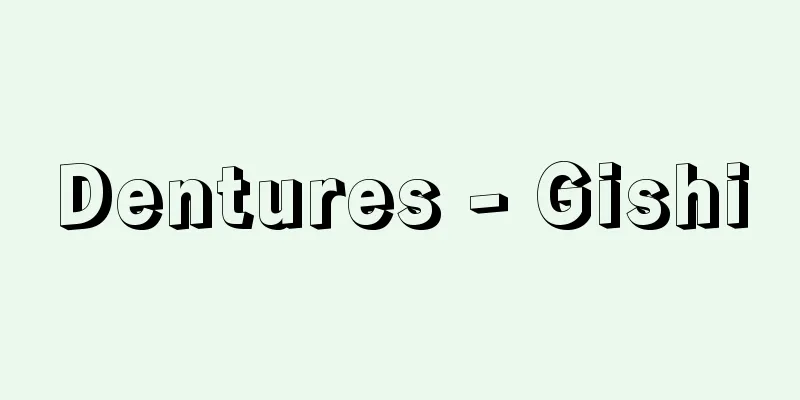Dentures - Gishi

|
A replacement device to replace lost teeth and surrounding tissues, also known as a "denture." It is used to restore oral functions such as chewing, pronunciation, and aesthetics. [Kenji Sawada] kindsDentures can be classified into those with a denture base to transmit the force of chewing to the jaw and those without a denture base; and into removable dentures, which can be attached and removed by the denture wearer themselves, and fixed dentures, which cannot be removed once placed in the mouth. Most removable dentures are dentures with a base, which can be further divided into complete dentures, where there are no remaining teeth and the dentures cover the entire mucous membrane of the alveolar ridge (jaw), and partial dentures, where retainers are attached to the remaining teeth (remaining teeth) to replace missing teeth. Most fixed dentures are non-retained dentures, also known as bridges. In addition, classifications based on the timing of dentures include immediate dentures (dentures made before tooth extraction and worn immediately after), early dentures (dentures made promptly after tooth extraction), and temporary dentures (dentures used temporarily until the final prosthesis is completed for treatment reasons, etc.). [Kenji Sawada] historyAround 3000-2500 BC, teeth have been found in the molar area of ancient Egyptian mummies with gold wire connecting them to each other, but it is unclear whether this was for prosthetic purposes. An example of something that was clearly made for prosthetic purposes is a gold bridge made by the Etruscans, thought to have been made around 750 BC. This involves using natural teeth in the missing area and wrapping them around the adjacent teeth with gold rings, and is thought to be the origin of modern bridges. In Arabic medicine in the early 11th century, artificial teeth made from bull bones were connected to the adjacent teeth in order to restore aesthetics and function. The first complete dentures as we know them today were made with wooden dentures (also called carved wooden dentures or wooden dentures), which are unique to Japan. The oldest surviving wooden dentures whose wearer is known date back to the Muromachi period, and are the upper complete dentures worn by Hotokehime (Nakaoka Tei, died 1538), a nun at Ganjoji Temple (Wakayama Prefecture). This wooden denture, which is more than 400 years old, is the oldest complete denture in the world, and is made by carving the denture base and artificial teeth as a single unit. Another famous example is the upper and lower dentures discovered in the grave of Yagyu Hida no Kami Munefuyu, lord of the Yagyu domain in the early Edo period. These are said to have been made by dentist Ono Gen'yu, and consist of artificial teeth made of gray-white wax stone attached to a base made of boxwood as the front teeth, and small needles were used for the molars. Wooden dentures are an adaptation of traditional Japanese woodcarving techniques used in the making of Buddhist statues and Noh masks. Overseas, the French dentist Fauchard is said to have invented the complete denture around 1737, but functionally it was inferior to wooden dentures. Before the 18th century, partial dentures were made in the form of bridges to compensate for partial loss of teeth, but Fauchard and others applied the techniques used to make complete dentures and devised metal hooks (springs) as retention devices in the mouth, thus completing the prototype of modern partial dentures. [Kenji Sawada] Complete denturesA complete denture is a set of dentures worn by patients who have lost all of their teeth in the upper or lower jaw. A complete denture consists only of a denture base and artificial teeth. Denture bases adhere to the oral mucosa to maintain and stabilize dentures, compensate for receding gums and jawbone, and help restore aesthetics and speech function. Denture bases are made of synthetic resin (polymethylmethacrylate resin) or metal (cobalt-chromium alloy, titanium alloy, etc.). The former are called resin-based dentures and the latter metal-based dentures. Resin bases have the advantages of being lightweight, inexpensive, having a color similar to that of the gums, and being repairable in the event of damage. On the other hand, they have the disadvantages of being prone to fracture if thin, so the denture base tends to be thick, which causes a strong foreign body sensation and makes it difficult to transmit heat. On the other hand, metal bases have the advantages of being strong enough even with thin denture bases, not feeling like a foreign body after wearing, and being able to transmit heat from food and drink to the oral mucosa. In order to ensure a good fit and stability of complete dentures, it is necessary to maintain a negative pressure between the denture base and the oral mucosa. To achieve this, the denture base is fabricated to cover as much of the alveolar ridge as possible without interfering with the movement of the lips, cheeks, and tongue, and so that the edges of the denture base are sealed with the oral mucosa. Artificial teeth come in a variety of sizes, shapes, and colors, and are so precisely and ingeniously made that they are difficult to distinguish from human teeth. Artificial teeth are made from synthetic resin or ceramics. The former are called resin teeth, and the latter are called porcelain teeth. Resin teeth have the advantages of being less likely to break, not wearing down opposing teeth (natural teeth), not making the unpleasant clicking sound that occurs when porcelain teeth bite together, and being chemically bonded to the resin of the denture base to prevent the artificial teeth from falling off or the denture base from breaking. On the other hand, compared to porcelain teeth, they have the disadvantages of being less abrasion-resistant and slightly water-absorbent, so that the shape, color, and transparency are likely to gradually change over time with use. When selecting the type of artificial teeth, for the anterior teeth, factors such as gender, age, occupation, facial features, and skin color are taken into consideration, while for the posterior teeth, artificial teeth are selected with consideration given to the bite. [Kenji Sawada] Partial denturesPartial dentures are dentures that are fitted using the remaining teeth as support, and are designed so that the force generated when chewing food with the dentures is borne by both the remaining teeth and the alveolar ridge. In addition to the denture base and artificial teeth, partial dentures are made up of metal bars (connecting rods) and retention devices. As with complete dentures, partial dentures use resin or metal for the denture base, and are called resin dentures and metal dentures, respectively. There are also resin and porcelain artificial teeth, and the advantages and disadvantages of both are the same as for complete dentures. The most distinctive components that make up partial dentures are the retention devices and metal bars. Retainers are devices that keep partial dentures in place and are made up of hooks and attachments. Hooks are attached to teeth that are suitable for retaining partial dentures in the mouth, using the elasticity of metal to hold them in place, and prevent them from falling off. There are two types of hooks: wires made of stainless steel cobalt-chromium alloy that are bent to fit the teeth, and cast gold-silver-palladium alloy or cobalt-chromium alloy. When hooks are used on the front teeth, special retainers called attachments are sometimes used to ensure aesthetics. Recently, there are also small retainers (a type of attachment) that use samarium-cobalt magnets, which have a strong magnetic force. In magnet-based retainers, magnets are embedded in the dentures, and metal plates that stick to the magnets are attached to the tooth roots (natural teeth) to keep the dentures in place. Metal bars are rod-shaped connecting devices that connect the denture bases together to make a single partial denture when teeth are missing in the upper or lower jaw, rather than inserting a denture one at a time into each missing tooth, and they are effective in preventing deformation or breakage of dentures, suppressing denture movement, and reducing the sensation of a foreign body in the dentures. Metal bars come in bent stainless steel wire and cast gold-silver-palladium alloy or cobalt-chromium alloy, and those placed on the palate mucosa of the upper jaw are called palatal bars, and those placed between the tongue and the lower jaw are called lingual bars. The size and shape of partial dentures vary depending on the number and location of missing teeth, and are divided into intermediate dentures with remaining teeth (hooks) on both ends of the missing teeth area, distal dentures that lack hooks on one end of the missing teeth area, and composite dentures in which intermediate dentures and distal dentures are connected by a metal bar. Intermediate dentures generally provide good denture stability and allow a significant portion of the occlusal force applied to the denture to be borne by the hooks, allowing the denture base area to be reduced. On the other hand, distal dentures require the oral mucosa to maintain and stabilize the denture as well as the remaining hooks, and most of the occlusal force is borne by the mucosa beneath the denture base, resulting in a larger denture base area. [Kenji Sawada] bridgeIt is also called a bridge or a brace. When one to three teeth are missing in the mouth, this denture requires the adjacent teeth to support the missing teeth and places all the chewing force on the adjacent teeth. It is composed of an abutment device that is placed on the adjacent teeth, a pontic (bracket) that replaces the missing teeth, and a connecting part that connects the two. There are various types of bridges, from anterior bridges or molar bridges to full bridges that cover the entire jaw, depending on the part where they are attached. In addition, there are inlay bridges, metal crown bridges, and porcelain crown bridges, depending on the type of abutment device. An inlay is a filling made by taking an impression of the teeth and casting it, and an inlay bridge is made by connecting it to a pontic. A pontic is an artificial tooth that replaces the missing teeth, but it is necessary to make the chewing force smaller than that of a natural tooth so that the chewing force transmitted to the abutment teeth is not too strong. In addition, in the molar area, it is necessary to make the space between the pontic and the gums easy to clean so that food particles do not become stuck between the pontic and the alveolar ridge, which can cause gingivitis. Since esthetics are important for anterior pontics, the part that can be seen from the front is made to have the same shape as a natural tooth, but the back of the tooth is made to make it easy to clean the space between the pontic and the gums. The abutment teeth of a bridge are selected from teeth with healthy periodontal tissues that can withstand a fairly large biting force, because they are also subjected to the biting force of the pontic that replaces the missing tooth. Usually, the teeth adjacent to the missing tooth are used, but the number of abutment teeth may need to be increased depending on the number and location of the missing teeth, and the strength of the biting force applied to the denture. Unlike partial dentures, bridges have a naturally limited range of application because all the biting force applied to the denture is applied to the abutment teeth. Even when the periodontal tissue is healthy, there is a proportional relationship between the surface area of the tooth root and its ability to withstand biting force, with the load capacity differing by several times between canines and first molars, which have strong roots, and lateral incisors and wisdom teeth, which have thin and short roots. When there are many missing teeth, a partial denture is considered to be appropriate instead of a bridge, but in some cases, a removable bridge, which is an intermediate type between a partial denture and a bridge, can be created by using an abutment device with attachments. [Kenji Sawada] Implant-supported denturesThis is a treatment method in which an artificial tooth root (implant) is placed in the alveolar bone where the tooth is missing, and is left to bond with the surrounding jawbone tissue, after which a prosthesis (continuous tooth, bridge or denture) is made and attached. The artificial tooth root that is implanted in the jawbone is made of metals such as hydroxyapatite, which has high tissue affinity, and titanium. In 1952, Per-Ingvar Brånemark (1929- ) of Sweden discovered that titanium could be semi-permanently bonded to bone without causing a rejection reaction, and the first clinical application of artificial tooth roots began in 1965. Since then, many researchers have been devising new materials and designs for artificial tooth roots. [Kenji Sawada] Care after dentures are fittedThe larger the denture, the stronger the foreign body sensation and discomfort caused by wearing dentures, and complete dentures cause the most discomfort. Fixed dentures cause the least discomfort. With a bridge designed to replace only a few missing teeth and with full consideration of the bite force load on the abutment teeth, dentures can function in the same way as natural teeth without any awareness of them. When brushing your teeth after wearing a bridge, it is important to note that dirt tends to accumulate around the pontic, so you need to brush your teeth at a more slant angle than when brushing your own teeth. When wearing removable dentures such as complete dentures or partial dentures, you should have your dentures maintained and your bite checked frequently at first. If you endure the pain, it can lead to secondary diseases such as ulcers on the oral mucosa and pain in the clasps. With partial dentures, you need to remove them after each meal to clean the dentures and also clean your mouth well. Furthermore, when wearing removable dentures, it is necessary to remove them before going to sleep to allow the oral mucosa to rest. To prevent dentures from drying out and becoming deformed, they should be stored in a visible container with water. Wrapping them in paper can lead to them being crushed or thrown away. With partial dentures, the retainers can become loose over time, making the dentures more likely to fall out, so the key to making them last longer is to have the fit of the dentures and the condition of the remaining teeth (hooks) checked regularly. [Kenji Sawada] [Reference] | | |Source: Shogakukan Encyclopedia Nipponica About Encyclopedia Nipponica Information | Legend |
|
失われた歯やその周囲組織を補うための代替装置で、「入れ歯」ともよばれる。そしゃく、発音、審美性など、口腔(こうくう)の機能回復に用いられる。 [澤田健次] 種類義歯の分類には、物を噛(か)む力を顎(あご)に伝えるための義歯床をもった有床義歯と、義歯床がない無床義歯とに分ける分類、義歯の使用者自身が義歯を着脱できる可撤義歯と、ひとたび口腔内に装着したら着脱不可能な固定義歯とに分ける分類などがある。 可撤義歯の多くは有床義歯であり、さらに残存歯が1本もなく、義歯が顎堤(がくてい)(あご)の粘膜全体を覆う全部床義歯(総義歯)と、残っている自分の歯(残存歯)に維持装置を設けて歯の抜けた部分を補う部分床義歯(局部床義歯)とに分けられる。また、固定義歯の多くは無床義歯で、ブリッジ(橋(きょう)義歯)ともいう。 このほか、義歯の装着時期に関する分類では、即時義歯(抜歯前に製作しておき、抜歯後ただちに装着する義歯)、早期義歯(抜歯後すみやかに製作する義歯)、暫間義歯(治療上の理由などで、最終的な補綴(ほてつ)物が完成するまで一時的に使用される義歯)などがある。 [澤田健次] 歴史紀元前3000~前2500年ころ、古代エジプト人のミイラの臼歯(きゅうし)部に、互いに歯と歯が金線で結ばれている例が発見されているが補綴のためであるかどうかは不明である。明らかに補綴の目的で製作されたものとしては、紀元前750年ころにつくられたとされるエトルリア人の金製ブリッジがある。これは、欠損部に天然歯を用い、黄金の輪で隣在歯に巻き付けたもので、現在のブリッジの元祖と考えられている。11世紀初めのアラビア医学では、雄ウシの骨でつくった人工歯を隣在歯に結び付け、審美性と機能の回復を図ったとされている。 現在のような全部床義歯がつくられるようになったのは、わが国固有の木床義歯(木彫義歯、木製義歯ともいう)が最初である。現存し、かつ使用者が判明している最古の木床義歯は室町時代のもので、願成寺(和歌山県)の尼僧、仏姫(中岡テイ。1538年没)が使用していた上あごの総義歯である。この400年以上前の木床義歯は世界最古の総義歯であり、義歯床と人工歯を一体として彫刻されたものである。また、有名なものに江戸初期の柳生(やぎゅう)藩主、柳生飛騨守宗冬(ひだのかみむねふゆ)の墓から発見された上下の義歯がある。これは歯医者であった小野玄入(げんにゅう)の作といわれ、灰白色のろう石でつくった人工歯をツゲの木を素材にした床につけて前歯とし、臼歯には小さな針を用いたものである。木床義歯は仏像や能面など、わが国伝統の木彫技術から発展、応用されたものである。 海外では、フランスの歯科医フォーシャールが、1737年ころ全部床義歯を考案したといわれているが、機能的には木床義歯より劣ったものであった。 部分床義歯は、18世紀以前には歯の部分的欠損を補綴する目的でブリッジ形態の補綴物が使われていたが、フォーシャールらによって全部床義歯作製の技術を応用し、口腔内への維持装置として金属鉤(こう)(ばね)が考案されるようになり、現在の部分床義歯の原型が完成された。 [澤田健次] 全部床義歯上顎あるいは下顎のすべての歯を失った患者に装着される義歯である。全部床義歯は義歯床と人工歯のみでできている。 義歯床は、口腔粘膜に吸着して義歯の維持安定を図り、退縮した歯肉や顎骨を補い、審美性や発音機能の回復を助けるものである。義歯床の材料は、合成樹脂(ポリメチルメタクリレート樹脂)または金属(コバルト‐クロム合金、チタン合金など)であり、前者をレジン床義歯、後者を金属床義歯とよぶ。レジン床は軽量、安価で、歯肉に近い色調が得られ、破損の場合にも修理可能等の利点があるが、反面、薄いと破折しやすいので義歯床が厚くなりがちで、したがって異物感が大きくかつ熱が伝わりにくい等の欠点がある。一方、金属床は薄い義歯床でも十分な強度があり、装着後の異物感が少なく、さらに飲食物の熱が口腔粘膜に伝わる利点がある。全部床義歯の良好な適合と維持安定を得るためには、義歯床と口腔粘膜との間が陰圧状態に保たれることが必要である。このためには、義歯床が口唇、頬(ほお)、および舌の動きを障害しない範囲で顎堤をできるだけ広く覆い、義歯床周縁が口腔粘膜で密封されるように製作される。 人工歯は、種々の大きさ、形態、色調のものがあり、人の歯と判別しにくいほどに精密、巧妙につくられている。人工歯の材料は、合成樹脂やセラミックスである。前者をレジン歯、後者を陶歯とよぶ。レジン歯は、破折が少ない、対合歯(天然歯)を磨耗させることがない、陶歯と陶歯が噛みあうときに生じる不愉快なカチカチ音がない、義歯床のレジンと化学的に接着して人工歯の脱落や義歯床の破折を防止するといった利点がある。反面、陶歯に比べると、耐摩耗性が低く、わずかに吸水性があるため、長期間の使用によって、徐々に形態・色調や透明感が変化しやすい等の欠点がある。人工歯の種類を選択する場合、前歯部では、性別、年齢、職業、顔貌(がんぼう)、皮膚の色などの条件を総合して行われ、臼歯部では、かみ合せを考慮して人工歯の選択が行われる。 [澤田健次] 部分床義歯部分床義歯は、残存歯を支えとして装着される義歯で、食物を義歯で噛むことによって生じる力を残った歯と顎堤の両者で負担するように設計した義歯である。部分床義歯は、義歯床・人工歯のほかに、金属製のバー(連結用の棒)、維持装置などによって構成されている。義歯床の材料としては、部分床義歯の場合も全部床義歯と同様にレジンあるいは金属が用いられ、それぞれレジン床義歯、金属床義歯とよばれる。人工歯についてもレジン歯と陶歯とがあり、両者の利点、欠点は全部床義歯の場合と同様である。部分床義歯を構成している構成要素として特徴的なものは、維持装置と金属バーである。 維持装置は部分床義歯を口腔内に維持安定させる装置であり、鉤、アタッチメントなどがこれにあたる。鉤は、金属の弾力を利用した把握作用によって、口腔内に残る自分の歯の中から部分床義歯の維持に都合のよい歯(鉤歯(こうし)という)に装着され、部分床義歯の脱落を防ぐ働きをする。鉤には、不銹(ふしゅう)鋼のコバルト‐クロム合金でできた金属線を歯にあわせて屈曲したものと、金銀パラジウム合金やコバルト‐クロム合金などを鋳造したものとがある。前歯に鉤を用いるときには、審美性に配慮する必要から、アタッチメントとよばれる特殊な構造をした維持装置が用いられる場合もある。また、最近では維持装置として小型でも磁力の大きいサマリウムコバルト磁石を用いた維持装置(アタッチメントの一種)もある。磁石を用いる維持装置では、マグネットを義歯に埋め込み、歯根(天然歯)には磁石に吸い付く金属板を装着して義歯を維持するのである。 金属バーは、上顎あるいは下顎において歯が飛び石状に欠損している場合、複数の欠損部分それぞれに1個ずつ義歯を入れていくのではなく、義歯床それぞれを連結して1つの部分床義歯とするための棒状の連結装置で、義歯の変形や破折を防止するとともに、義歯の動揺を抑え、義歯の異物感を少なくする効果がある。金属バーには、不銹鋼線を屈曲したものと、金銀パラジウム合金やコバルト‐クロム合金を鋳造したものとがあり、上顎の口蓋(こうがい)粘膜面に設置するものをパラタル・バー、下顎の舌との間に設置するものをリンガル・バーとよぶ。 部分床義歯の大きさや形は、欠損歯の数と位置によって異なり、歯の欠損部の両端に残存歯(鉤歯)がある中間義歯と、欠損部の一端に鉤歯を欠く遊離端義歯、および中間義歯と遊離端義歯が金属バーでつながった複合義歯とに分けられる。中間義歯は、一般に義歯の維持安定がよく、義歯に加えられる咬合(こうごう)力のかなりの部分を鉤歯に負担させることが可能であり、義歯床の面積を小さくすることもできる。一方、遊離端義歯は、残っている鉤歯とともに、口腔粘膜部によって義歯の維持安定を図る必要があり、咬合力の大部分を義歯床下の粘膜が負担することとなるため、義歯床の面積は大きくなる。 [澤田健次] ブリッジ橋義歯、あるいは架工義歯ともよばれる。口腔内で1~3歯が欠損喪失している場合、欠損に隣接する歯に維持を求め、噛む力を隣接する歯にすべて負担させる義歯のことで、隣接歯に設置する支台装置、歯の欠損部を補うポンティック(架工歯)、および両者をつなぐ連結部によって構成されている。ブリッジの種類としては、装着される部位によって前歯ブリッジ、あるいは臼歯ブリッジとよばれるものから、全顎にわたるフルブリッジまである。また、支台装置の種類によって、インレー・ブリッジ、金属冠ブリッジ、陶材冠ブリッジなどの種類がある。インレーとは、歯型をとって鋳造してつくる歯の詰め物で、これとポンティックを連結してつくるブリッジがインレー・ブリッジである。ポンティックは、欠損部を補う人工歯であるが、支台歯に伝わる咬合力が大きすぎないように、本来の歯よりも噛む力を小さくするくふうが必要である。また、ポンティックと顎堤との間に食片が停滞して歯肉炎にならないように、臼歯部ではポンティックと歯肉の間を清掃しやすい形態にすることが必要である。前歯部のポンティックでは審美性が重んじられるため、前から見える部分は自然の歯と同じような形につくるが、歯の裏側は歯肉との間を清掃しやすいようにつくる。ブリッジの支台歯には、歯の欠損部を補うポンティックの咬合力も加わるので、かなり大きな咬合力に堪えられるだけの健康な歯周組織をもった歯が選ばれる。通常、歯の欠損部の両隣接歯を用いるが、欠損歯の数、部位、および義歯に加わる咬合力の強さによって、支台歯の数を増加させる必要が生じる。ブリッジは部分床義歯と異なり、義歯に加わる咬合力がすべて支台歯に加わるため、適応範囲はおのずから制限される。歯周組織が健康な場合でも、歯根の表面積と咬合力の負担能力とは比例関係にあり、歯根のしっかりした犬歯や第一大臼歯と、歯根が細くて短い側切歯や智歯(ちし)(親知らず)では負担能力が数倍異なる。欠損歯の数が多い場合には、ブリッジではなく部分床義歯の適応症と考えられるが、アタッチメントを用いた支台装置を利用して、部分床義歯とブリッジの中間型の可撤性ブリッジとよばれるものをつくる場合もある。 [澤田健次] インプラント義歯歯の抜けた部分の歯槽骨に人工歯根(インプラント)を植え込み、周囲の顎骨組織と結合するまで待ち、その後、補綴物(継続歯、ブリッジあるいは義歯)を製作して装着する治療法である。顎骨に埋入(まいにゅう)される人工歯根の材料としては組織親和性の高いハイドロキシアパタイトや、チタン(チタニウム)などの金属が用いられる。1952年スウェーデンのブローネマルクPer-Ingvar Brånemark(1929― )が拒絶反応をおこすことなく骨とチタンが半永久的に結合することを発見し、1965年から人工歯根として初の臨床応用を開始して以来、多くの研究者によって人工歯根の材料やデザインがくふうされている。 [澤田健次] 義歯装着後の管理義歯装着による異物感、違和感は義歯の大きさが大きいほど強く、全部床義歯における違和感がもっとも強い。違和感のいちばん少ないのが固定義歯のブリッジである。欠損した歯の本数が数本で、支台歯の咬合力負担を十分に考慮して設計されたブリッジでは、義歯を意識することなく、天然歯と同様の機能を営ませることができる。ブリッジ装着後の歯みがきにおいて注意すべき点は、ポンティックの周囲は汚れが停滞しやすいので、自分の歯をみがくときよりも、さらに歯ブラシの角度を寝かせて歯に当てる必要があることである。全部床義歯や部分床義歯などの可撤性義歯を装着した場合、初めのうちは義歯の維持や咬合状態を頻回チェックしてもらう必要がある。痛みがあるのにがまんをしていると、口腔粘膜に潰瘍(かいよう)を生じたり、鉤歯に痛みがおきたりという二次的な疾患を招くことになる。部分床義歯では、毎食後外して義歯の清掃をするとともに、よく口腔清掃する必要がある。また、可撤性義歯を装着した場合、就寝時には義歯を外して口腔粘膜を休ませる必要がある。外した義歯は乾燥による変形を防ぐため、中身が見える容器に水を入れて保管しておく。紙に包んでおくのは、押しつぶしてしまったり、捨てられてしまったりするおそれがある。部分床義歯では、使用しているうちに維持装置がゆるくなって義歯が脱離しやすくなることもあり、定期的に義歯の適合状態や、残存歯(鉤歯)の状態をチェックしてもらうことが義歯を長持ちさせる秘訣(ひけつ)である。 [澤田健次] [参照項目] | | |出典 小学館 日本大百科全書(ニッポニカ)日本大百科全書(ニッポニカ)について 情報 | 凡例 |
Recommend
Dog beetle - Dog beetle
… There are about 60 known species of tongue beet...
Udokan - Udokan (English spelling) Удокан/Udokan
A copper mine in Chita Oblast, central Russia. Lo...
Dessert Culture - Dessert Culture
A prehistoric culture that was distributed in arid...
Armpit - Armpit
A term used in Noh. A professional who plays a su...
Forty-two Chapters of the Sutra
This sutra is said to have been the first Buddhist...
Floating Dock - Uki Dock
A floating structure for inspecting and repairing ...
Indigo master - Aishi
…The harvested indigo leaves are finely chopped, ...
Ono Gon'emon
A wealthy merchant in the early Edo period. A memb...
Basic wage - Kihonchingin
…Wages in Japan had become extremely complicated ...
Cigarette beetle
...The antennae are serrated. The English name is...
Katsushika prefecture
...At the end of the Edo period, Hitachi Province...
Ryoseki Flora - Ryoseki Flora
This is the general term for fossil plants found i...
makhzan
…The fundugs, which were common in the Mediterran...
Joint Venture
A joint venture is a legal entity formed by multip...
Supersensitization - Supersensitization
…The mechanism by which energy is transferred fro...









